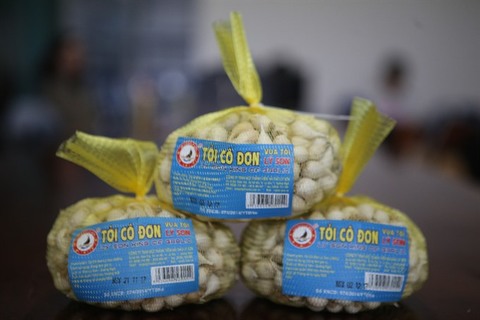
Packages of registered Ly Son garlic is seen at a shop on the mainland. — VNS Photo Cong Thanh
The sale of garlic falsely marked as Ly Son garlic has damaged the brand name of the major crop of the Ly Son Island in recent years.
Despite the efforts of local authorities, garlic products from Ninh Hien in Khanh Hoa Province and Phan Rang of Ninh Thuan Province, sold under the Ly Son trademark, have dominated the local market – where the famous crop had been rooted for generations.
Poor measures to control fraudsters and a lack of brand protection have added to unfair competition among farm produce.
Additionally, the local government has yet to find a solution to the common issue of prices plummeting after a bumper crop.
“Islanders saw a bumper harvest this year with total 2,500 tonnes of dried garlic on 300ha of farms, but it could only be sold at VND60,000 (US$2.6) or VND70,000 ($3) per kilo at the island’s centre market. Meanwhile, Ly Son brand garlic was sold at VND100,000 ($4.4) in mainland supermarkets” said vice chairwoman of the island district’s people’s committee, Pham Thi Huong.
Huong slammed the fake garlic products from Khanh Hoa and Ninh Thuan, which were shipped from mainland to the island, resulting in lower prices.
Poor protection
The vice chairwoman said the district seized 620kg of garlic that was headed from Khanh Hoa to the island last year.
She said fraudsters are mostly Ly Son-born farmers who have been living in Khanh Hoa Province’s Ninh Hien commune. They often took garlic seeds from the island to farm in Khanh Hoa and Ninh Thuan before transporting the garlic back to the island to falsely sell it as the more expensive Ly Son garlic, she said.
“We have conducted constant inspections, but some traders intentionally mixed different garlic products in packages without any label or certificates of origin. Only islanders could recognise original Ly Son garlic, but not tourists,” Huong said.
Duong Ngoc Son, an islander, said garlic from other provinces were easier to grow on mainland’s farms, and these products could be sold at VND30,000 ($1.3).
“Fraudsters could earn triple when they disguised fake garlic as Ly Son garlic. It damages the protected brand of the island. We face losses when Ly Son garlic is priced at VND60,000 (US$2.6) for a dried kilo at the moment,” Son said.
“I’m sure that Ly Son garlic could supply enough for tourists and registered supermarkets in the mainland,” he said.
He blamed the local government for not tackling fake garlic, with inspections of cargo ships from the mainland poor and small fines ineffective.
Son said the brand ownership for the products of Ly Son Island including garlic, onion, seafood, garlic wine, dried seafood and seaweed were recognised by the National Office of Intellectual Property of Viet Nam, under the Ministry of Science and Technology, for 50 households and individuals on the island in 2007.
However, the anti-counterfeiting stamp and logo of the Ly Son products have yet to be issued and tourists are still confused about fake and original garlic even on the island.
Vice chairman of the Island’s Garlic and Purple Onion Processing and Trade Association, Nguyen Van Dinh suggested that heavy fines, joint-inspections of border guards and market watch forces at all ships at ports and original certificate stamps on Ly Son products could help stop fake garlic trading.
“Our association has 100 members who are Ly Son farmers. We live on garlic and purple onion farming. The fake garlic could result in bankruptcy among farmers, while fraudsters could live well,” Dinh said.
He said Ly Son garlic seeds planted in Khanh Hoa and Phan Rang often have double productivity compared to those on Ly Son Island.
“Islanders spend too much on labour and disaster risks in farming garlic on the island. The soil is a mixture of basalt, white sand, fertiliser and limited fresh water. Consumers could hardly recognise the difference between garlic from Khanh Hoa and Ly Son Island as the two garlic products are about 80 per cent similar,” Dinh said.
He added that Ly Son garlic could only clearly be identified due to its milky colour and tiny cloves, while Ninh Hien and Phan Rang garlic products are bigger and whiter.
Dinh confirmed that original Ly Son garlic is only sold at the central market in Ly Son Islands, Big C supermarkets on the mainland and registered trademark shops.
According to Ly Son People’s Committee, the local government has been building Geographical Indication (GI) for better protection of Ly Son garlic.
The island, known as the Kingdom of Garlic in Viet Nam, has 21,000 inhabitants, of whom 73 per cent make their living from farming garlic and spring onions or fishing.
A high-tech farm producing organic garlic has been built on the island, with a total investment of $177,000.
The island produced 2,500 tonnes of garlic and 6,500 tonnes of purple onion from 1,000ha of farmland last year. — VNS